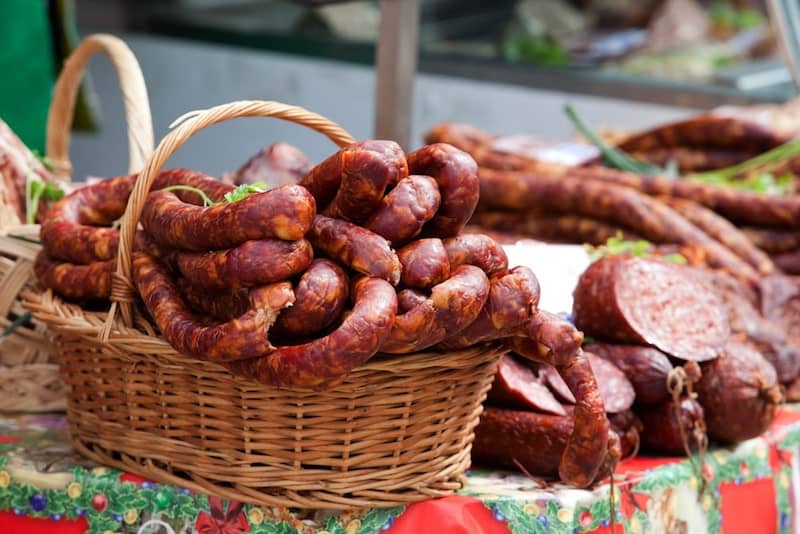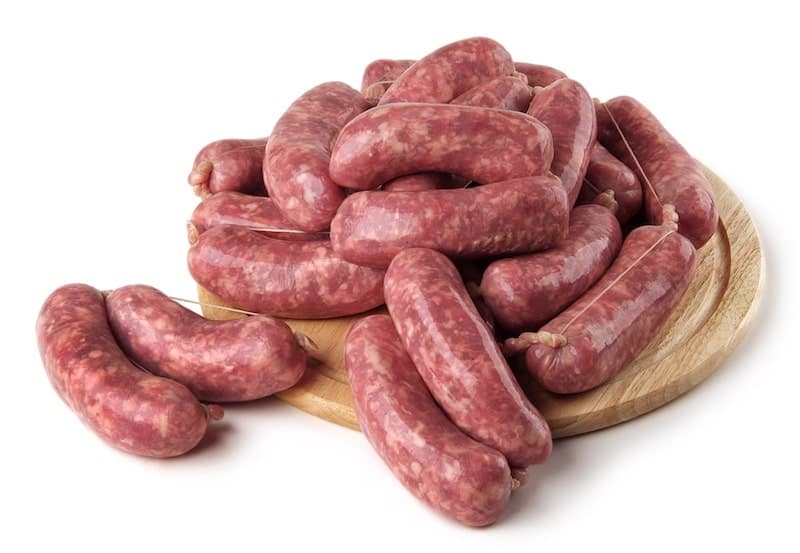Longaniza vs. Chorizo (Similarities and Differences Explained)
All across the world for centuries, butchers and home cooks have created various sausage recipes by stirring ground meat together with herbs and spices. Sausages frequently reflect local flavors and when traveling, you may be able to enjoy local culture by enjoying the locally made sausage.
Spicy and meaty with the flavors of several herbs and spices, both chorizo and longaniza are kinds of sausages that are frequently used in ethnic cooking, often to add a bit of a kick to different dishes.
While they may look similar when you see them at the store, there are some significant differences between longaniza vs chorizo.
| Longaniza | Chorizo |
|---|---|
| Made from pork and sometimes other meats | Always made from pork |
| Generally cooked in slices with the casing on | Eaten cured or can be cooked without the casings, like ground meat |
| Long, thin sausages | Short, fat sausages |
| Flavors and spices vary depending on where in the world you find it | Flavors and seasonings may vary, depending on where in the world you find it |
| Origins in Spain | Spanish origins |
| Flavored with salt, garlic, paprika, and regional herbs | Seasoned strongly with paprika, but also includes garlic, salt, and other spices |
| Milder than chorizo sausage | Spicier than longaniza sausage |

What Is Longaniza?
Longaniza is generally a pork sausage that’s eaten with the sausage casing on, although in some places other kinds of meats may be included.
It may resemble in appearance something like a salami or a pepperoni, but the flavor is much bolder and spicier than pepperoni or salami.
While some places do cure their longaniza, the majority of cultures don’t cure this flavorful meat. The meat is sold as fresh and raw, and it is generally cooked with the casings on the meat like a sausage link.
Varieties of Longaniza
Now that we know that longaniza is a long, thin sausage powerfully flavored with various herbs and spices, let’s dive into the ethnic varieties of longaniza.
Exactly which mixtures of herbs and spices included in the longaniza depends on which area of the world the longaniza comes from.
Longaniza originated in Spain, but it’s now found in various places all over the world. Any place that the Spanish had colonized centuries ago has their own versions of this delicious pork meat based sausage.
Spanish longaniza is flavored strongly with black pepper and nutmeg.
Longaniza from Argentina and Uruguay features ground anise seeds, which give it a unique and aromatic flavor and smell.
In these countries, longaniza is often cured but not cooked, and it is used frequently in sandwiches or in an appetizer dish.
In Chile, longaniza is served at barbecues and is often a part of nationwide festivals that celebrate historical events in the nation.
Mexican longaniza is heavily spiced and frequently served with eggs on a tortilla as a breakfast dish.

Longaniza is also frequently made and eaten in the Philippines. Filipino longaniza comes in two versions. They have a garlic flavored version and a sweet version of these delicious sausages.
The exact spices and flavorings in a longaniza vary greatly in the Philippines based upon which ethnic group in the island nation created it. There are hundreds of versions of longaniza in the Philippines!
You can even find longaniza in the United States. Because of the influx of immigrants from Central and South America and the renewed interest in ethnic styles of cooking, Latin markets frequently carry longaniza.
In most major US cities, you may have good luck finding this delicious sausage. If you live in a more rural area with a significant immigrant population, your local grocery store may even carry longaniza in its refrigerated meat section.
How to Eat Longaniza
If the sausage is cured, you may not need to cook it, but if it is fresh, or raw, you should cook it in some way.
Slice the longaniza into rounds before cooking the sausage. Longaniza can be cooked on the grill, fried in a pan, or even baked in the oven.
If you’re cooking longaniza, you can use an instant read meat thermometer to test the meat. You should cook it until it reaches 165 degrees Fahrenheit.
It’s not unusual for longaniza to be cooked with rice or even eggs.
What Is Chorizo?
Chorizo is a kind of pork sausage that’s finely ground and stuffed into sausage casings (however, in some cultures, the meat is generally removed from the casings and cooked as ground meat – more on this below).
The pork meat (and sometimes other parts of the animal) is flavored with salt, paprika (or sometimes smoked paprika), chili pepper, and garlic among others. Pork fat is also mixed into the ground meat to provide extra flavor and moisture.
The main ingredients, however, are ground pork, paprika, salt, and garlic. The paprika is used in such great quantities that the sausage has a bright red color.
Varieties of Chorizo
Like longaniza, chorizo also has Spanish origins, and it’s also very popular in Mexico.
Mexican chorizo is a spicier sausage that’s sold raw. Spanish chorizo, on the other hand, is sold cured and can be smoked.
People who live in the Cajun areas of the United States are also big fans of this spicy sausage and in these areas, like in Louisiana, the sausage is called Cajun sausage.
In the US, you can buy this sausage fully cooked with a texture similar to pepperoni or salami, or you can buy it semi cured and fully cooked.
Chorizo is also frequently eaten in the Philippines, Portugal, Puerto Rico, and Panama. Again, like longaniza, in any place whose culture was influenced by the Spanish, you will probably find chorizo.
How to Eat Chorizo
Spanish chorizo is often enjoyed with cheese on a charcuterie board, or it can be cooked with eggs and eaten as a breakfast dish.
Mexican chorizo is delicious in tacos or burritos. You can also find chorizo in meatballs and chili to add a lovely appearance and spicy flavor. It’s also frequently found in soups and stews and in stuffing for poultry.
This meat is very versatile since it can be enjoyed as is in the casing (usually Spanish chorizo) or removed from the casings and used as a ground meat (usually Mexican chorizo).
Chorizo has a high fat content, and because of that, if you’re preparing fresh chorizo, you probably won’t need to add extra oil to your pan when you’re browning it. The pork fat in the meat will melt and cook the ground pork.
If you’re preparing raw chorizo, first remove the casing by slitting it down the long side and unrolling the pork meat from the casing.
You can cook the chorizo in the exact same way that you cook ground beef, after you have removed the casing. Just use a spatula to chop and turn the chorizo until it is browned and fragrant.
Because there’ll be so much fat in the skillet along with the meat, you may want to drain this excess fat before you stir the pork into your recipe.
What Are the Similarities Between Chorizo and Longaniza?
Chorizo and longaniza are very similar kinds of sausage. They’re both made from ground pork and stuffed into casings.
Although, in some areas of the world, longaniza may be made from ground poultry or beef. In fact, some places use multiple kinds of meat in the longaniza.
Both longaniza and chorizo are red in color and feature paprika and garlic as prominent ingredients.
Both kinds of sausages can be used in similar types of recipes. For instance, both kinds are popular as a breakfast meat to accompany eggs. In Hispanic areas of the world, both are served with eggs on a tortilla as a sort of breakfast sandwich.

They also both vary depending on the area of the world in which they are made. After all, cooks generally adapt their recipes to reflect regional tastes and ingredients that are locally sourced.
It should be no surprise that butchers, chefs, and home sausage makers adapted both chorizo and longaniza in different areas.
While these sausages are found all over the world, let’s not forget that they both got their starts in Spain.
What Are the Differences Between Chorizo and Longaniza?
The biggest difference between chorizo and longaniza is the way that they’re both used.
Chorizo can be removed from the casing and used as a ground meat, while longaniza is most often sliced and served with the casings on.
Another big difference between the two sausages is that chorizo is generally a lot spicier than longaniza. Both kinds of sausages have their own sorts of flavoring (especially depending on what region you’re in), with the chorizo sausage depending greatly on paprika and hot peppers.
Longaniza is formed into long, thin links, while chorizo is fatter and shorter than the longaniza version.
Chorizo is pretty much always made from pork, but you might find longaniza made from pork, beef, or ground poultry.
Finally, chorizo is also significantly higher in fat compared to longaniza.
In Summary
Sausage is made all over the world, but in areas of the globe that have been highly influenced by Spanish culture, both chorizo and longaniza sausage are favorites.
Both versions of these popular sausages are frequently consumed for many different kinds of meals and used to add a spicy zing to various dishes. Even in areas like the United States, chorizo has become an integral part of Cajun cuisine.
When it comes to comparing longaniza vs chorizo, both have their own distinctive merits, but it is certain that when you want to add a bit of spicy flavoring to eggs, a casserole, or a soup recipe, either sausage may be appropriate for your recipe.
Interested in how other types of sausages compare to chorizo? Check out my other articles that compare chorizo to:







